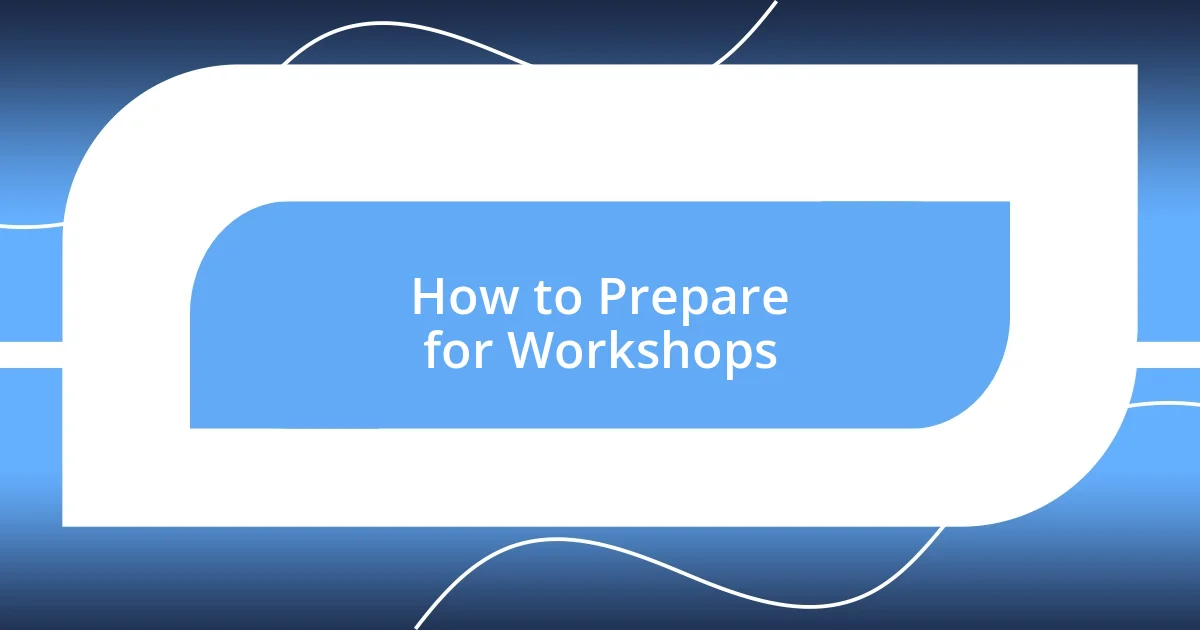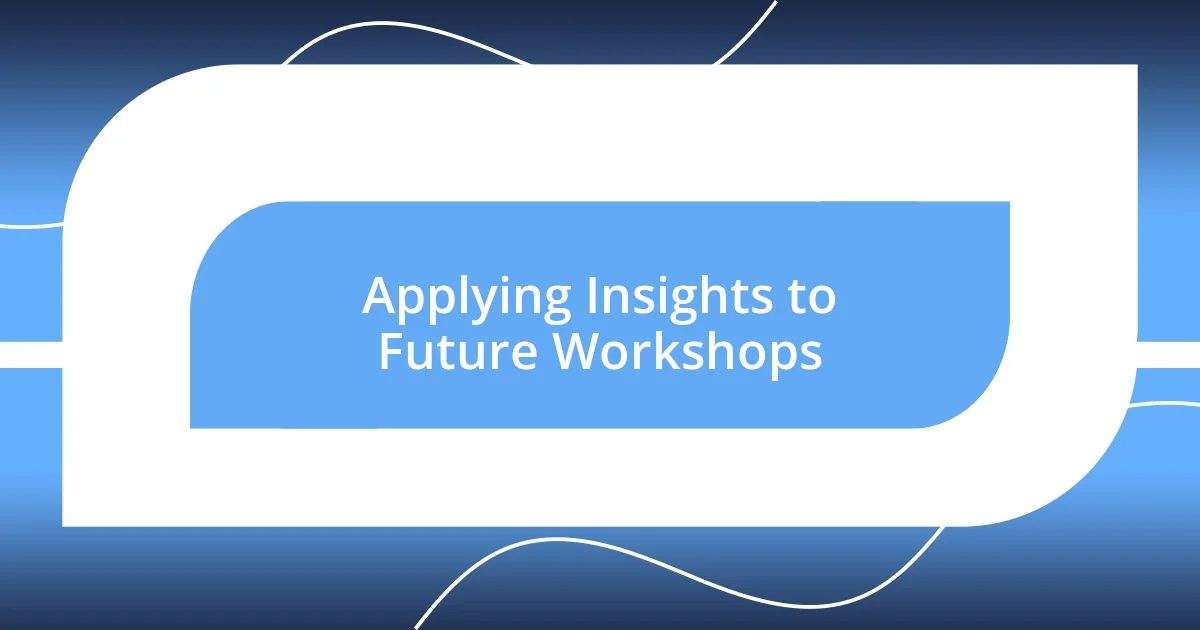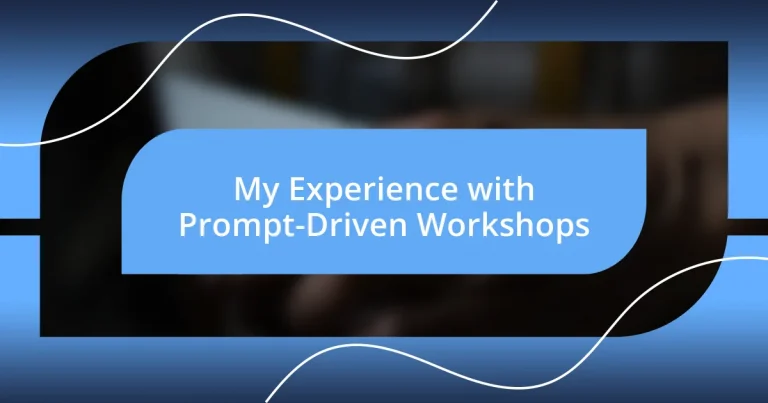Key takeaways:
- Prompt-driven workshops foster creativity and collaboration by using engaging prompts that challenge participants to think outside their comfort zones.
- Key preparation strategies include embracing an open mindset, bringing creative materials, and familiarizing oneself with the workshop format for better engagement.
- Collecting feedback through qualitative methods and applying insights helps enhance future workshops, promoting a sense of ownership and accountability among participants.

Understanding Prompt-Driven Workshops
Prompt-driven workshops are designed to spark creativity and encourage participants to delve deeper into their ideas through guided prompts. I remember my first experience—sitting in a circle with strangers, each of us holding a slip of paper containing a prompt. It was strangely exhilarating and a little intimidating, but the shared vulnerability fostered an environment where everyone was eager to explore and express.
These workshops often create a unique atmosphere of collaboration and spontaneity. I found that my initial hesitations melted away as I engaged with others, bouncing ideas back and forth. Have you ever felt that rush of inspiration when someone else’s perspective opens a door you didn’t know existed? That’s what makes these sessions so powerful; they allow us to connect and grow through shared experiences.
What struck me the most was the way prompts could challenge us to think outside our comfort zones. One prompt from a session asked us to describe a world where traditional communication methods no longer existed. Honestly, it was a little jarring at first, but it forced me to really stretch my imagination and consider new realities. Isn’t it fascinating how a simple question can unlock such profound discussions and insights?

The Benefits of Prompt-Driven Workshops
The beauty of prompt-driven workshops lies in their ability to enhance creative thinking. I remember a moment in one workshop when I struggled to come up with anything meaningful. Then a prompt about “the colors of your emotions” suddenly flooded my mind with vivid images and memories. That shift from hesitation to inspiration was remarkable; it reaffirmed my belief that prompts can serve as powerful catalysts for self-discovery.
Some key benefits of prompt-driven workshops include:
- Boosted Creativity: Participants tap into new ideas they might not have explored otherwise.
- Enhanced Collaboration: Sharing responses fosters a sense of community and trust among participants.
- Increased Confidence: Engaging with diverse perspectives helps build self-assurance in expressing one’s thoughts.
- Emotional Insights: Prompts often evoke personal reflections, leading to deeper understanding of oneself and others.
Each benefit contributes to a rich environment where creativity flourishes, allowing us to connect with our inner selves and each other in profound ways.

How to Prepare for Workshops
When preparing for a prompt-driven workshop, the key is to embrace an open mindset. I remember rolling into the session, excited yet anxious about sharing my thoughts with new people. What I discovered was that letting go of the fear of judgment can transform your experience. It’s all about being ready to explore ideas, even if they seem a bit silly at first. Have you ever noticed how the best insights sometimes emerge from our most whimsical thoughts?
Additionally, gathering materials beforehand can be incredibly helpful. In a workshop I attended, I brought along sketchpads and colored pencils. Surprisingly, these tools allowed me to visualize my ideas in a way that words sometimes couldn’t capture. I found that the combination of prompts and creative expression led to breakthroughs I never expected. So, consider what materials might enhance your experience; every little bit can help.
Lastly, familiarizing yourself with the workshop format can set the stage for a smoother experience. When my friend and I attended a session focused on storytelling, we made sure to read up on narrative techniques. Knowing what to expect allowed us to engage more confidently. Engaging with the structure beforehand can demystify the process, ensuring you’re not just a participant but an active contributor to the conversation.
| Preparation Strategy | Description |
|---|---|
| Mindset | Embrace openness and let go of fear about sharing ideas. |
| Materials | Bring along creative tools to visualize your prompts. |
| Familiarization | Understand the workshop format for confident engagement. |

Essential Techniques for Effective Prompts
To create effective prompts, tailoring them to the audience is crucial. I remember attending a workshop where the facilitator asked us to write about “our childhood heroes.” The responses were varied and rich, revealing not just our aspirations but also our vulnerabilities. Have you ever noticed how a well-crafted prompt can unlock stories you didn’t even know were waiting to be told?
Another technique that consistently proves invaluable is being open-ended in prompt design. During a particularly engaging session, one prompt asked us to describe “a moment that changed everything.” This invitation sparked profound reflections, leading to an unexpected sharing of life-altering experiences. It highlighted for me how prompts that encourage expansive thought create an authentic space for connection.
Finally, timing matters—a lot! I’ve found that giving participants sufficient time to reflect before sharing their responses can make a world of difference. In a workshop where we had three minutes of silence to contemplate a prompt, it felt like the room filled with energy. Those moments allowed ideas to gather momentum, resulting in discussions that were not just insightful, but deeply moving too. How do you think a little extra time could change your workshops?

Facilitating Engaging Workshop Activities
When it comes to facilitating engaging workshop activities, I’ve learned that interaction is key. I recall a session where we split into small groups to brainstorm ideas. The energy shifted immediately; there was laughter, excitement, and a flurry of opinions. It’s fascinating how breaking into smaller units encourages everyone to voice their thoughts, which often prompts more profound discussions. Have you ever felt that spark when collaborating closely with others?
Creating a safe space for sharing is another vital element. In one workshop, the facilitator made a point of establishing ground rules around respect and openness. I noticed how participants became visibly more relaxed as they recognized that their contributions were valued. This type of environment encourages creativity and supports risk-taking in sharing ideas. It makes me wonder, what might we achieve if everyone felt truly safe to speak their minds?
Lastly, incorporating movement during activities can enhance engagement significantly. A memorable workshop featured a “gallery walk” where we pasted our ideas on the walls and roamed around to discuss them with others. The physical movement not only broke the monotony but also revitalized our thinking. I found myself revisiting points I wanted to deepen as I moved from idea to idea. Isn’t it interesting how our bodies can influence our minds in such dynamic ways?

Measuring Outcomes and Feedback
Measuring outcomes and feedback in prompt-driven workshops has become one of my favorite ways to assess the effectiveness of the activities. After one particularly enlightening session, I created a quick online survey to capture participants’ thoughts. I was amazed at how openly many shared their takeaways, revealing insights that I hadn’t anticipated. Can you imagine the wealth of information that can help shape future workshops when you simply ask for feedback?
In another instance, I implemented a “plus-delta” exercise where participants shared what they liked (the pluses) and what could be improved (the deltas). This method transformed feedback into a collaborative experience rather than a one-sided critique. It felt powerful to see how attendees embraced constructive suggestions, fostering a sense of ownership over the workshop’s evolution. Have you ever considered how collective input can create a stronger bond within the group?
I’ve also learned that qualitative feedback often tells a richer story than numbers alone. During a reflective closing session, I invited participants to express their feelings about the workshop using metaphors. The range of responses was striking—from “a warm embrace” to “a rollercoaster ride”—and they revealed the emotional impact that prompts had on them. Reflecting on those words, I realized just how vital our emotional responses are in measuring true outcomes. What do you think could happen if we prioritized emotional feedback as much as the numerical ones?

Applying Insights to Future Workshops
There’s something incredibly valuable about actively applying insights gathered from previous workshops into future ones. Reflecting on one particular session, after receiving feedback about the lack of visual aids, I decided to be more intentional in design for the next workshop. I remember creating bright, engaging slides and infographics that not only captured attention but also reinforced key concepts. Have you ever noticed how even simple visuals can make complex ideas much more digestible?
Another insight I’ve embraced is diversifying the types of prompts used during workshops. I vividly recall a moment when a thought-provoking question opened unexpected dialogue among participants. Inspired, I gathered a variety of prompts that could stimulate creativity and critical thinking, from quirky icebreakers to debate-style questions. This experimentation made our sessions richer and allowed for more spontaneous learning. Isn’t it amazing how a single prompt can unlock a treasure trove of thoughts?
Finally, I’ve learned that closing workshops with action items significantly increases accountability. In one memorable session, we ended by having each participant commit to a specific goal based on what they’d learned. The atmosphere was electric; it felt like we were all leaving with a mission. Implementing this practice has not only encouraged follow-through but has also fostered a sense of camaraderie and shared purpose. Don’t you think that these kinds of commitments can transform theoretical discussions into tangible results?













